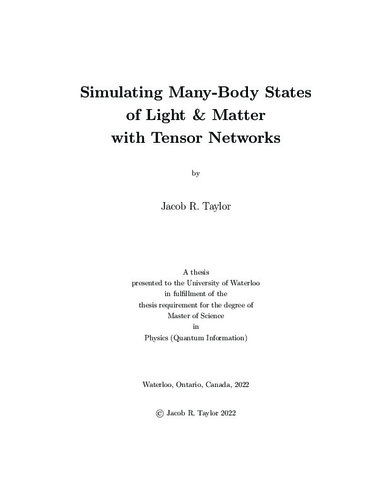| dc.description.abstract | When Feynman originally proposed the concept of a quantum computer, his purpose was to perform quantum simulation of complex materials. It is thus a key requirement that quantum resources can emulate physical processes that occur in nature. This is not only true for advancing our understanding of physics, but also for validating that these quantum devices work "at scale" in the first place. With recent developments, the realization of fully-controllable quantum devices of N~ 200 qubits has become a reality. The memory requirements to store the state of such a device is soon to surpass the total memory capacities available on earth.
Given a physical state, full quantum-state tomography requires an exponential number of measurement basis for the characterization. Hence, it is also necessary to develop qualitative methods and phenomenology to make conclusive statements without direct access to the full physical state in the laboratory. One inherently useful aspect for this type of "benchmarking" is to understand quantum phases of low-energy states of a many-body system. Being able to simulate complex ground states is not only useful for discovery of novel phases of matter, but is also necessary requirement to validate the "supremacy" of a quantum device. Moreover, simulating physics on quantum devices currently is very difficult and, due to their noisy nature, untrustworthy. Both as a stop gap in device validation and in laboratory limitations where some access to the wavefunctions is required, improving the state-of-art methodology for classical simulation of many-body systems will remain an important direction in the foreseeable future. This thesis focuses mainly on state-of-art tensor-network toolboxes to simulate static and dynamical behaviours of highly-complex many-body systems, exemplified by both local and non-local properties of the quantum matter.
In chapter 1, I motivate the rest of the thesis and provide an introduction to the physics of cavity quantum electrodynamics (QED), and its generalized cousin, waveguide QED. In particular, I describe how the range of quantum phases can be expanded using local constraints and site-independent cavity modes. Finally, I provide a summary for the remaining chapters.
In chapter 2, I describe state-of-art numerical toolboxes to efficiently represent and manipulate quantum states, namely the tensor network method that controls the approximation of wavefunctions in an exponentially-large Hilbert spaces with the entanglement degree of freedom spread across a network of heavily sparse and compressed tensors. The crucial insight of these so-called tensor network states is discussed, where the approximation of the wavefunction is made by limiting its entanglement degree of freedom, also known as the bond dimension. We provide a physically relevant picture of the AKLT representation of matrix product states (MPS) for the compressability and expressibility of most low-energy states of many-body systems in low dimensions, colloquially known as the area law of entanglement.
We describe two well-known examples for variational 1D-like tensor network states, known as MPS. The two prominent optimization toolboxes are the density-matrix renormalization-group (DMRG) and time-dependent variational protocol (TDVP), as well as their infinite-size variants. We conclude this chapter by discussing new methods of simulating open-system dynamics for many-body systems in the Markov limit using tensor network methods. The first is to perform a direct MPS-based quantum trajectory simulation of an open quantum system. The second is to create a new MPS representation of a vectorized density matrix for the open quantum system, and to determine the steady-state using DMRG-based methods.
In chapter 3, I provide an experimental protocol for generating universal quantum matter in a waveguide QED platform by coupling collective atomic motions of the trapped atoms to the continuum of waveguide modes. This spin-mechanical coupling generates universal (QMA-complete) 2-local Hamiltonian. Using this platform, we extend the methodology to generalized interacting SU(n) models. We describe several models implementable with the platform, such as the chiral spin liquids with DMI term, Kitaev honeycomb model, and an interacting SU(n)-model. I will discuss the application of tensor network states in emulating 1D SU(n)-spin chain across a quantum critical phase known as a quantum Luttinger liquid. This conformal phase, described by a Wess-Zumino-Witten (WZW) conformal field theory (CFT), is a proximate gapless spin liquid phase in one-dimensions. From this, we extract conformal data, such as the central charge and critical exponents from the physical spin model. Finally, we discuss the engineering challenge for realizing such a photonic crystal waveguide, including the effects of Casimir-Polder forces on the trapped atoms. We discuss a controlled renormalization procedure to obtain the gauge-invariant Hamiltonian analytically as well as the gauge-invariant matrix product state through the applications of isometric tensors. This chapter is largely based upon Ref. \cite{dong2021waveguide}.
In chapter 4, I discuss how novel quantum phases can be created in strongly-coupled many-body QED. Reactive many-body QED for a chequerboard lattice generates a Rydberg ice coupled to the cavity back-action. The long-range quantum fluctuations disseminate dimer coherence across the system size, generating long-range entanglement. The "infinite-range" quantum fluctuations have a profound impact on the stability and projective symmetry group of the spin liquid state in a dynamical U(1)-lattice gauge theory. We discuss the physical model underlying this platform. We find that Higgs-condensation of scalar charges spontaneously breaks the U(1) gauge group to a Z2 sub-group. A genuine deconfined phase persists in this setting, enabling the exploration of topological order within the Rydberg quantum ice. We discuss and utilize several methods for detecting quantum spin liquids. This work supplements our experimental observations, which will be discussed elsewhere. This chapter is largely based upon the Ref. \cite{Taylor2022}.
Finally, in chapter 5, I provide an overview of future directions for this work. The utilization of tensor networks within a quantum device, so called quantum tensor networks, could offer deep insight to the physics of strongly-correlated quantum systems. This is utilized to the physics of many-body QED for dissipative universal quantum computation. | en |

